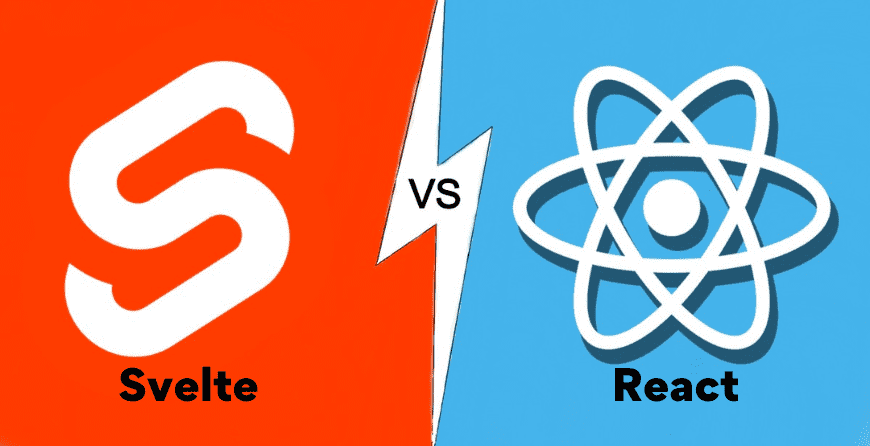Table of Contents
Introduction
Picking the right tool to develop your projects is a hustle. With new frameworks and protocols getting developed every year, it is hard to choose a pick. A similar situation arises between Svelte vs React. React.JS at this point is one of the most popularly used JavaScript frameworks. Svelte on the other hand is new, but gaining massive popularity each day and is now getting considered a worthy rival to React framework.
So, is Svelte better than React? Does React still hold value in the market? Is Svelte hard to learn? We will discuss all of these questions in this article and will assess between Svelte vs React performance, and which framework is better for your development project.
Before we start to differentiate between Svelte framework vs React, let’s first look at the concepts first.
Svelte vs React: React

ReactJS was created by Facebook back in 2011 as a JavaScript library. Ever since it became public, it is gaining immense popularity. React can be used to build any complex or lightweight applications, websites and highly interactive user interfaces. In fact, hiring React developers can help you gain a competitive edge in creating the best websites for your projects.
React has been at the top of its game and the primary choice of front-end developers across the globe. It is also easy to learn, gives lots of creativity and flexibility to the developers, quickly renders web pages and has an SEO-friendly nature.
How Good is React For Business?
If we compare Svelte vs React JS, React is easier to maintain with its flexibility. React’s components increase the productivity of front-end development, which in turn helps businesses save a lot of money and time. Furthermore, React’s codes are reusable which helps in writing concise and simple codes hence, helps in delivering a better UI experience to users. It also has a positive impact on the market and company goals.
React is a stable JavaScript framework which is used in most of the applications developed today. With that in mind, you know that you can easily hire developers at a reasonable cost. Moreover, React’s ease of coding and flexibility allows faster page rendering and boosts SEO results which makes it easier for your business to drive traffic.
When To Use React?
React, as we said, is a flexible library and is perfect for management. Apps and Websites that are developed in React can use and exchange data without reloading the page. Hence, any interface that requires a high amount of user interaction should implement React.
React can also manage low-level algorithms. React.JS is mostly used for the ‘view model’ of the interface hence it is apt to code with it without requiring any complex algorithm. In fact, React’s virtual DOM also helps in improving the performance and rendering of web pages and apps.
So, that was an introduction to React. Now, let’s talk about the second topic of our Svelte vs React debate.
Svelte vs React: Svelte

Svelte is a new edition, released in 2016. It is also an open-source frontend framework. It is component-based and works like a compiler. Svelte is a relatively new framework based on the already existing traditional browser-based frameworks, hence, has better features and upgrades. Though Svelte still has its pros and cons, but you can be assured that the pros are much higher! And for good reasons.
Is Svelte good for business?
By 2022, Svelte has completed 6 years and has been popular ever since its conception. Though React is still the first choice for developers but it is interesting to know that for popularity between Svelte vs React 2022, Svelte took the top spot for ultimate user satisfaction.
We are not saying that React is losing its base, but it is just the statistics we have gained. It will be interesting to see who ultimately becomes the preferred choice. To say whether it is good for business or not, the short answer is yes.
Its popularity is because it is not only giving client satisfaction but is also becoming a preferred choice of developers. Both are good for business as ultimately the goal is to provide a great user experience and Svelte is doing it perfectly thus far.
When To Use Svelte?
Svelte has a simple and concise coding framework, often resembling that of Vanilla JavaScript. Developers can easily accomplish their goals with fewer lines of code. If developers are writing codes for small package sizes for their websites, they should prefer Svelte.
Svelte programs are helpful for creating applications for low-capacity or low-power devices. Between the Svelte framework vs React, Svelte has the advantage of controlling routing, state management and building customized architecture. It is also helpful for reactive frameworks and DOM manipulations.
That was the introduction of Svelte vs React JS. Now let’s move on to their differences:
Svelte Vs React: Comparisons
One technical difference between Svelte vs React.JS is that Svelte doesn’t require third-party tools like React. Both frameworks have different aspects and tools which developers can choose from. Let’s look into such differences and find out which works better.
Svelte Vs React: Performance
Traditional Document Object Model (DOM) triggers an update with each code change, which slows down the app’s performance. Virtual DOM speeds up the process by acting as temporary memory storage for changes made to the user interface. A process known as diffusion or reconciliation delays updates until updating and rendering can be carried out effectively.
![]()
React uses Virtual DOM to break down the app’s code when the code is executed. VDOM helps React perform faster than traditional JavaScript languages. But Svelte takes performance a bit further by ignoring the VDOM diffing process.
Svelte acts as a compiler that carries out DOM rendering through reactive programming. Whenever an assignment triggers a change in the component stage, the DOM is updated. Thus, as a serverless-first framework, Svelte is considered more reactive than React.
Svelte Vs React: Speed
Svelte is more lightweight. Because of its size, the web application loads faster, the responsiveness is flawless, and the bandwidth costs are lowered.
React’s development pace is fast. Really fast. So fast it’s hard to keep up at times, which is often cited as one of its disadvantages. Svelte’s development process is even faster. How’s that possible?
The generated code is more readable, simpler, and way shorter than React’s. You can achieve similar results with less code, without the fear of compromising the quality. This in turn means that the project is easy to maintain and even easier to debug. And if there are any new team members added to the Svelte project, they can quickly understand what’s happening and start working immediately.
In React, one of the hurdles is JSX, an XML–like syntax to JavaScript meant for building user interfaces. Svelte uses an easier syntax and it has its own templating language that’s effortless to grasp.
Svelte Vs React : Popularity
React is still the most popular web framework. However, this survey was not limited to frontend frameworks and included frameworks like ASP.NET, Ruby on Rails, Laravel and more. According to a State of JS 2021 survey, Svelte has a higher level of satisfaction among developers. 90 per cent of developers are satisfied with Svelte, and 84 per cent are satisfied with React. In this same survey, Svelte was voted the most loved framework.
Svelte doesn’t have a rich community though. Because React is so popular, as proven by the influx of React apps, it has a giant community of passionate developers who make all sorts of tutorials and guides (often for free), and are readily available for brainstorming sessions.
Svelte can’t count on the same level of community support. The lack of plugins, integrations and IDE support is particularly bothersome. There are very few fixed best practices that could serve as a guide. And if you stumble upon a problem, the small user base might not be able to help you out.
Svelte vs React: Testing
Code written in React can be tested with ‘end-to-end’ tests. React code of an application is tested in a realistic browser environment. This reduces your app’s time to market (TTM) and boosts its value.
Svelte offers its testing library for unit testing. The Svelte testing library is smaller in size than React and offers simple computations. Thus, Svelte can help developers maintain clean, functional, and compressed code.
Svelte vs React: Bundle Size
Svelte’s .gzip version has a size of 1.6 kilobytes. React.gzip, when combined with ReactDOM, has a total size of 42.2 kilobytes.
The smaller bundle size of Svelte ensures faster loading speeds, better responsiveness, and lower bandwidth costs.
Svelte vs React: Who Wins?
The Svelte vs. React argument is straightforward when the project requirements are clearly defined. Use Svelte for your projects to achieve a smaller bundle size, maintainable code, and exceptional performance without the VDOM. Due to the simplicity of the framework, Svelte enables developers to prepare a website faster.
Using React for your projects can be made even easier if you hire software developers. React makes it easy to maintain the stability of your application. An active community of React developers helps resolve doubts and bugs observed during development.
Developing stable software products using React and Svelte requires companies to hire experienced software developers. Optymize can help you hire brilliant, pre-vetted remote software developers for your projects at unbelievable prices. Hire here.







